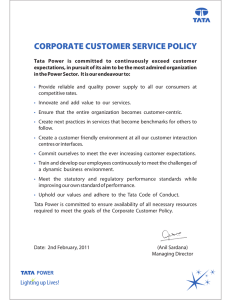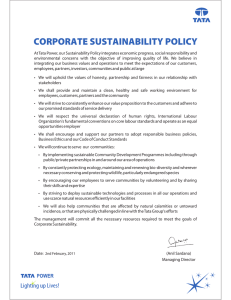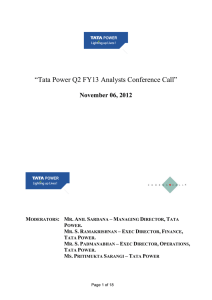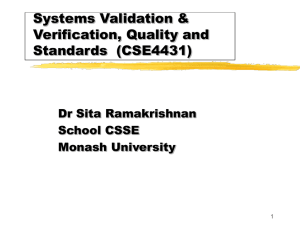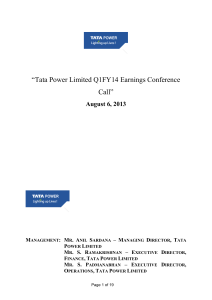“Tata Power FY13 Analyst Conference Call” May 30, 2013 –
advertisement
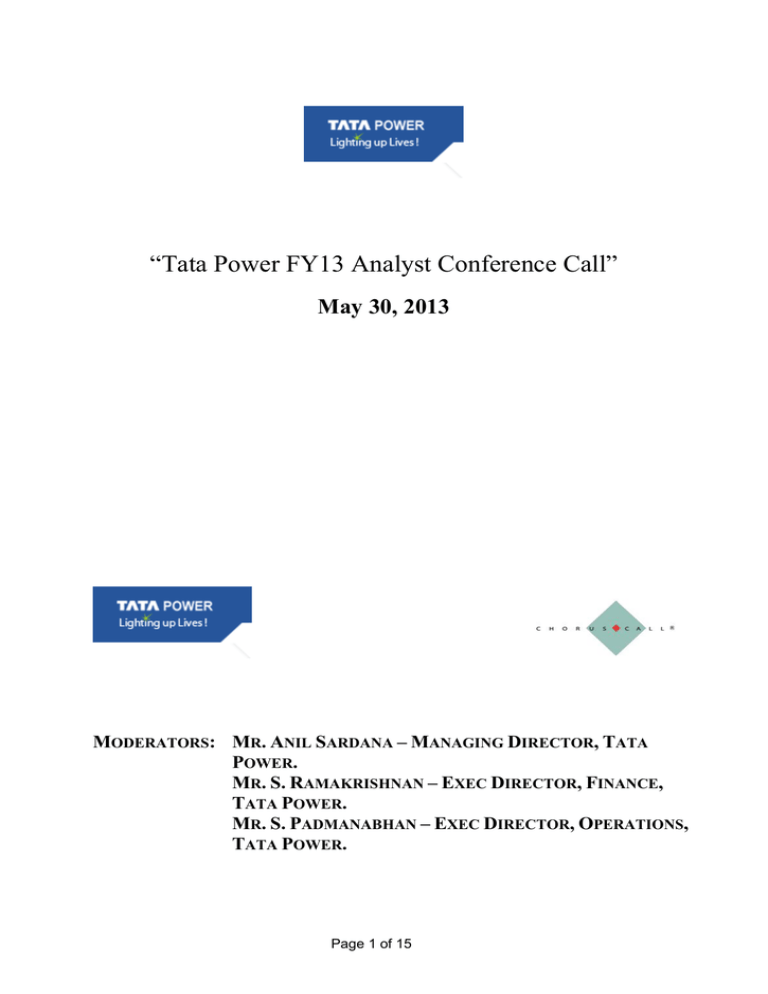
“Tata Power FY13 Analyst Conference Call” May 30, 2013 MODERATORS: MR. ANIL SARDANA – MANAGING DIRECTOR, TATA POWER. MR. S. RAMAKRISHNAN – EXEC DIRECTOR, FINANCE, TATA POWER. MR. S. PADMANABHAN – EXEC DIRECTOR, OPERATIONS, TATA POWER. Page 1 of 15 Tata Powers May 30, 2013 Moderator Ladies and gentleman, good day and welcome to the Tata Power FY13 Analyst Conference Call. We have with us today from Tata Power, Mr. Anil Sardana – Managing Director; Mr. S. Ramakrishnan – Executive Director, Finance and Mr. S. Padmanabhan – Executive Director, Operations. As a reminder, for the duration of the conference, all participants lines will be in the listen-only mode, there will be an opportunity for you to ask questions at the end of today‟s presentation. Should you need assistance during this conference call, please signal an operator by pressing * and then 0 on your touchtone phone. Please note that this conference is being recorded. I would like to hand the conference over to Mr. Anil Sardana. Thank you and over to you sir. Anil Sardana Thank you and good afternoon, welcome to all for our analysts friend on this call. We will look at the FY2013 standalone and consolidated results, as also Q4 standalone and consolidated results. The details have already been circulated to you. You must have seen that both for Q4 as well as for the last year, the operating profit has been far better than the previous years including previous quarters, and supported by that the company has been able to perform well. We continue to have challenges at Mundra, we are awaiting the committee appointed to decide on the compensatory tariff to conclude quickly and that is one key focus that we are all working on. And once that comes through, then the company will be able to manage much better results in different aspects. So without taking much time I would rather look forward to your questions and then all my colleagues here and I will try and respond to them with the best of our ability. Thank you and good day. Moderator: Thank you. We will now begin the question-and-answer session. The first question is from the line of Prakash Goel from ICICI Securities. Please go ahead. Prakash Goel: A couple of questions; first, with regard to Bhumi operation. The coal processing cost has gone up significantly during the quarter. Any specific reasons? And what will be the sustainable level of cost? S. Ramakrishnan: The costs have gone up both in terms of per tonne as well as in terms of production plus because of the dollar/rupee exchange rate. All the three have contributed to the increase. I think the statement mailed by us include split up between these three. Prakash Goel: Yes, I have seen that, I am just trying to understand what led to 108 crore on account of higher cost of processing. Is it sustainable? What has it been in terms a dollar rate per tonne, the overall cost of coal sold? S. Ramakrishnan: You want the coal processing charge per tonne or… Page 2 of 15 Tata Powers May 30, 2013 Prakash Goel: No, basically the overall cost number that you share every quarter? S. Ramakrishnan: The cost of production is $44.3 for the quarter compared to last year $47.3. Prakash Goel: Can you share the realization number for the quarter? S. Ramakrishnan: The realization number is FOB $72.3 compared to last year same quarter 92.6. Prakash Goel: And the volume, both sales and production? S. Ramakrishnan: Coal sold is about 19 million tonnes this quarter; last year it was about 16 million tonnes. Production is about 19.6 million tonnes, last year was 16 million tonnes. Prakash Goel: What is the cash level and the debt level at the coal subsidiaries? S. Ramakrishnan: Coal SPV cash position is 51 million compared to 111 million, that is because the SPV returns some of the loan back to India, the parent. That outstanding external debt remains at 790 million. Prakash Goel: How much money has been lent to India? You are saying besides the dividend? S. Ramakrishnan: 100 million was given back to India. Prakash Goel: In the form of dividend or in form of loans? S. Ramakrishnan: In form of loans, return of the loans. Prakash Goel: Second question is with regard to Mundra. Just wanted to find out the realization in the other cost. S. Ramakrishnan: Rs.2.39 per unit this quarter. Prakash Goel: And the coal cost? S. Ramakrishnan: Coal cost is Rs.1.84 per unit. Prakash Goel: And average blending of the coal? S. Ramakrishnan: I do not have that figure. We will get it for you. Prakash Goel: Basically, what I am trying to understand is that there is an impact of underutilization of port because of the take or pay and same is the case with shipping, if we utilize that for the overall capacity utilization…? Page 3 of 15 Tata Powers May 30, 2013 S. Ramakrishnan: I do not think we are anywhere underutilization at this point of time because throughput of volumes coal consumed is large enough now, with all the 4 units in operation. Prakash Goel: For the full quarter? S. Ramakrishnan: We are only talking about the quarter, so you can ignore the take or pay obligation. Prakash Goel: Rs. 1.84 is something where we are…? Anil Sardana: I think last time you had asked this from the point of view of the coal capacity charges, etc. But that is not an issue because now the full volume is being imported. Prakash Goel: What I was trying to understand is, is there any still underutilization impact on this Rs.1.84? Anil Sardana: There is none. Prakash Goel: Any dividend this quarter from Bhumi that you have received? S. Ramakrishnan: You are talking about Bumi to coal SPV. Prakash Goel: No, coal SPV paying dividend back to India? S. Ramakrishnan: Nil. Moderator: Thank you. The next question is from the line of Parag Gupta from Morgan Stanley. Please go ahead. Parag Gupta: Just on CGPL, if I look at on a sequential basis, your EBITDA has seen a significant improvement, you recorded an EBITDA of about $900 million in 3Q and this quarter, that is about $2.3 billion. Can you just explain to us what has led to this massive improvement in EBITDA? S. Ramakrishnan: This quarter we have been able to purchase certain opportunistic coal from North America and Columbia plus I guess it is the full utilization of without needing to take or pay obligation loan. So these are the two factors effectively contributing the increase and the coal prices are lower. Parag Gupta: So when you say that you have been buying a lot of coal from the US and Columbia, is this largely low grade coal? S. Ramakrishnan: I did not hear the word „lot‟ when I spoke. Maybe you did. I only said that I have been buying opportunistic coal lot sometime, not a lot of coal. Page 4 of 15 Tata Powers May 30, 2013 Parag Gupta: And do you think that this opportunistic buying may potentially increase or do you think the levels …? S. Ramakrishnan: By the nature of opportunistic, it depends on the demand/supply situation because coal manufacturers are bit stranded because their generator has moved to shale gas and freight element looks attractive at this point of time, when it will cease to be we do not know. We buy when the going is good on an opportunistic basis. That is why we are saying it is not a long term established situation, it is more of an opportunistic situation. Effectively, coal price has been falling, taking that into consideration it has also contributed to the increase in EBITDA. Parag Gupta: Because on a fuel cost per unit basis, your 3Q was Rs.1.92 and this quarter is about Rs.1.84, so… S. Ramakrishnan: I do not want to put all the claims on to my opportunistic buying of coal, the only point I am making, it is also due to the general decrease in price. Moderator: Thank you. The next question is from the line of Bhavan Vithalani from Axis Capital. Please go ahead. Bhavan Vithalani: Two questions; one, since the UMPP has now stabilized. Would it be possible for you to share some details on the heat rate and auxiliary consumption? What has been the station heat rate? In one of the conference calls you highlighted this. S. Ramakrishnan: A better time for us to give you this is maybe another 6 months down the line, because these quarters, we have done certain performance test and other things also, so some of these may not be realistic at this point of time. Bhavan Vithalani: In one of the conference calls, you had highlighted that it will be in the region of 2000 to 2100 and… Anil Sardana: You need to understand, Bhavan, why S.R. is saying that it may not be an apt time because we are mixing too many coals from different destinations. When we do that, the efficiency part of the boilers takes a beating. Right now, we go upwards of 2150, etc. But when you stabilize the source as well as boilers, that is what we call as tuned boilers. At that time, one can then give the right figure. S. Ramakrishnan: Range indicated which you quoted now, we do not believe that is the wrong range. Every indication that we have at this point of time, somewhere in that range we should be able to get that. Bhavan Vithalani: Will parameters like auxiliary consumption and your O&M cost also vary… Page 5 of 15 Tata Powers May 30, 2013 Anil Sardana: We can validate the figure. If you tell us what figures are you using for auxiliary part Bhavan Vithalani: About 6%. Anil Sardana: No, it will be much higher; it will be upwards of 8.4%. Bhavan Vithalani: The O&M cost, rupees per kilowatt hour basis? S. Ramakrishnan: We never do in Kilowatt hour. You are making your model making very simple. O&M is a part of fixed cost. Bhavan Vithalani: The other question was now assuming the CERC decision…. Anil Sardana: If I can indulge with you on that part, the reason why you cannot do that is because we will operate at different levels, O&M cost remains fixed, the people, the spares, the AMCs, everything remains fixed. So it is not going to change the kilowatt hour. Most of the stuff like coal consumed can be kilowatt hour. It gives a good reflection when you talk about kilowatt hour. But O&M, you should never talk kilowatt hour. You should spread it to the units that get generated is different. That is how you arrive at kilowatt hour. So it is a derived figure, but you should not put into the model to ask somebody that what is the O&M cost per kilowatt hour. That is just to engage with you. Bhavan Vithalani: My second question was assuming the CERC gives a favorable judgment on the UMPP Anil Sardana: That they have given. Bhavan Vithalani: No, on the final outcome. Anil Sardana: Committee first gives that. Bhavan Vithalani: If you can outline what will be the expansion plans given that we do not have any major projects lined up after the UMPP? Anil Sardana: You know that we have applied for 2x800 for the purpose of clearances. Now, this process for clearances as we are told is close to about 18 months to 24 months. Let us progress with that, by the time more clarity would come I am sure and therefore we will be able to share more details with you. Bhavan Vithalani: And the progress on the 450 MW at Tata Steel, Kalinganagar? Anil Sardana: As of now, we have got the environmental clearance for that expansion and we are now working on various other aspects. Page 6 of 15 Tata Powers May 30, 2013 Bhavan Vithalani: So besides these two, any other projects that we should be expecting or we should be closely monitoring? Anil Sardana: We announced the Georgia project where we said that we are going to be building a 400 MW Hydro. So that has been formally announced. We have finalized everything. We in fact got consent for construction. So we will get you more details about that if you are interested. Moderator: Thank you. The next question is from the line of Amit Sinha from Macquarie. Please go ahead. Inder: This is Inder here from Macquarie. Regarding our coal operations in Indonesia. Now, there have been reports about possible disruptions there and disputes with one of the key contractors. Can you say what is currently happening at the site and is the production and everything on schedule, on track? Anil Sardana: As far as dispute is concerned, I think you should touch base with the Arutmin and KPC people. As far as the production is concerned, we exited the previous quarter with 19.1 million tonnes of sales. As far as we are concerned, we believe we are on course. Inder: So we will kind of hold on to our full year target of around 75 odd million tonnes of production? Anil Sardana: That is correct. Inder: There is no issue about key contractor payments and those kinds of issues which can…. Anil Sardana: Any operations of that size when you produce 75 million tonnes of coal, there are always issues related to contractor and contractor payments, etc. But I think those are operationally issues and we might do well to talk to the management there. Inder: Regarding the CERC-formed committee, now, original order was supposed to have a timeline of around a month for this to adjudicate and come off with some kind of a formula. Where do we exactly stand there as to, in the sense, what timeline this will take? And in a related case, where Haryana has gone to Supreme Court challenging this, I would say, Appellate Tribunal, does that in any way impact our case also? Anil Sardana: Two parts to your question. First, let me deal with the second part which you said Haryana has gone to Supreme Court; they have gone to Appellate Tribunal. So they have gone to APTEL saying that please take our input, give us time extensions for our right to come back to you in case we are interested in coming back on the matter. And as you know, that right exist with every beneficiary and that right exists with us also, because this is very clearly a CERC‟s interim order. So therefore, it is more based on their legal advice that they must have done that because they have also said in the same petition there that we want to sit in the committee and Page 7 of 15 Tata Powers May 30, 2013 we want to cooperate with the committee. So that is your second question. Now, on the first question that you asked in terms of time, I have absolutely no wherewithal to answer that in terms of any predictable time, I only know one thing that all five beneficiaries have now given their names; the last one coming only last week. So now that all names are in, I guess, they should be in the business to discuss this but how much time will they conclude I have no idea. And whether they have gone back to regulatory commission to say that we need more time beyond stipulated 30 days or recommended 30 days, I have no idea. Inder: Does a mandated process whereby the beneficiaries or the buyers have certain amount of time to kind of consult and come back as to what is an acceptable proposal to them, just to get an idea as to how long this whole consultation process can take? Anil Sardana: I think we will have to do legal consultation to understand whether we can go and do any intervention either with the committee or with the regulator on this matter. As of now, I guess, we have had the patience, we are running the plant, we waited all this while, we could wait another few days or weeks or whatever is needed to see whether there is any sort of a sanity in the committee to conclude it fast enough. Moderator: Thank you. The next question is from the line of Abhishek Tyagi from CLSA. Please go ahead. Abhishek Tyagi: First question regarding the Coal business. There was a press article about China not importing low GCV coal going ahead. Will it in any way impact our sales from our Indonesian coal mines and what proportion of coal currently is low GCV, which we produce in Arutmin and KPC? Anil Sardana: Again, more details you could have from KPC and Arutmin. What we can send you is that based on the projections we have, we are moving on target. We had sales in the previous quarters which were on target and we hopefully are seeing things moving even during this quarter which is reasonably on target. So, at this stage, we cannot predict how things would change there. But I guess I still want to suggest that this information can be precisely taken from KPC, Arutmin. Abhishek Tyagi: Regarding your CAPEX. What was the figure for FY13 for the consolidated company and what is the targeted CAPEX if you can guide us for FY14? Anil Sardana: We have for standalone, we do not have for consolidated, but we will work that out and send it across. Abhishek Tyagi: I had another question on NDPL. Whether for the fourth quarter there is any exceptional item as well because profit figure is quite high at 117 crores. Is there any settlement of overdues or something like that in NDPL? Page 8 of 15 Tata Powers May 30, 2013 Anil Sardana: No. Moderator: Thank you. The next question is from the line of Devanshi Dhruva from NVS Brokerage. Please go ahead. Devanshi Dhruva: Actually, I just wanted to ask one question that we read the news that Tata Power is planning to add 1,600 MW at Mundra Power Project. So I would just like to ask you how would you be funding this new expansion out there? Anil Sardana: This is little early or premature stage for us to talk about funding aspect. We are at this stage pursuing consent and once we have the line up sight on the approvals that are forthcoming, we will then start to charter those aspects in terms of funding needs, etc. Devanshi Dhruva: Any broad idea you all would be having about it at least? S. Ramakrishnan: When we get all the approvals. Moderator: Thank you. The next question is from the line of Venkatesh from Citigroup. Please go ahead. Venkatesh: Can you share with us what was the depreciation in the coal mine in the fourth quarter and the full-year last year? S. Ramakrishnan: We will give it to you. Ask your next question. Venkatesh: The next question is what is your consolidated debt figure at the end of the year? S. Ramakrishnan: 33,000 Crs. Venkatesh: That should be a leverage of almost 3 times. Are you comfortable with these kinds of numbers or is there any thought process about raising equity because the leverage seems almost 3 times. S. Ramakrishnan: I said I am quite comfortable. I hope my lenders are. Venkatesh: Coming to the final set of questions, these are all related to the compensatory tariff hike that the CERC has agreed on. When they are actually giving you this tariff hike, what exactly is your interpretation in terms of why they are giving you this tariff hike? Is it… S. Ramakrishnan: Once that order come… Venkatesh: No, I am not asking about actual numbers that you will get 30 paise or 50 paise, I am just asking what do you think is the thought process. Is the idea that you need to make a certain ROE on the project or are they trying to make sure that the interest and the debt gets repaid? Page 9 of 15 Tata Powers May 30, 2013 Anil Sardana: Do you have the order or should I mail you a copy of the CERC order? Venkatesh: I do have a copy of it. Anil Sardana: So it is very clearly written saying that there is a pain in terms of the fuel prices not getting recovered through the tariffs that is there. And since there has been unprecedented price increase, as also that all sources today have actually come out with newer concepts in terms of either change of law or issues related to carbon tax, etc., therefore, there is a challenge in terms of managing the fuel price and therefore the regulator wants that the unprecedented change in pricing should be compensated. That is exactly the reason why compensatory tariff board has been formulated. So there is not much …. Venkatesh: The reason I am asking, if you actually read the tariff order, it clearly says that we are not giving this tariff order because it is a change in law, we are not giving this compensatory tariff hike because it is a force majeure. He has argued that this is a contract between two parties. The intention of the CERC is to make sure that the contract gets honored. They do not want the contract to get frustrated. So if the contract has to be honored and the…. Anil Sardana: I think you are missing a word, my dear friend. First, second part you said is right, there is no change in law, there is no force majeure. The third word that you use is wrong. They said that there is frustration in the contract, because there has been unprecedented price increase… Venkatesh: I agree. There has been frustration. That is what I said. They do not want the contract to get frustrated, they want that contract to go on so that Tata Power continues to generate power, that contract gets maintained. Now, to generate power and to honor the contract, the only thing that is required is to make sure that the interest and the debt get repaid. Anil Sardana: They have not said that. Venkatesh: No, I am asking you, what is your interpretation, because… Anil Sardana: Why should I interpret? They have said that the fuel price is not getting recovered through the tariff, and that is where without opening the existing bid tariff; let us compensate them for the fuel price that is over and above what they are able to recover. Matter is over. That is what they have said. Venkatesh: What about this statement that net profit earned by supplying coal from Indonesia to Mundra UMPP at a higher benchmark price, what is that interpretation? Is the profits which are being made in the coal mines that Tata Power is making, will be shared with the beneficiaries in this…? Page 10 of 15 Tata Powers May 30, 2013 S. Ramakrishnan: What they have said is if the price increase has led to increase cost of X million, same X million purchase at increased price would have added to the profit of Tata Power. So to that extent of the X million contributing to the increase profits, you make adjustment. You cannot only look at one side, look at both sides to that. It does not say the full investment. It says to the extent of the purchase made by the Mundra company in the coal company. Venkatesh: But when they say profit, do they actually mean profit after tax or is it at the EBITDA level? S. Ramakrishnan: It is profit after tax, arising out of the increase in price. Please understand, the price is what is causing us pain in India. Hopefully, it is giving you pleasure because of your holding in Indonesia. So they are saying share that pleasure if you want the pain to be removed, to the extent whatever million tonnes are causing the pain, would be causing some pleasure, whatever is the pleasure you give it. So, we are paying tax is also part of the pain. So the pleasure is after all the taxes and everything. Venkatesh: Would you get this? Because there is no clarity on whether this compensatory tariff hike will happen on the … S. Ramakrishnan: Full year 340 million and quarter is 92 million. Venkatesh: On the same compensatory tariff hike, is there any thought process in whether you will get it retrospectively, because your plant has been operating for almost 1.5 years? Anil Sardana: It is written. S. Ramakrishnan: Whatever the days from where the pain Moderator: Thank you. The next question is from the line of Harish Bihani from CIMB. Please go ahead. Harish Bihani: Can you share the deferred tax amount for standalone and consolidated only for the full year? I have a couple of more questions on the balance sheet. Also, wanted the consolidated gross blocks and capital work-in progress? S. Ramakrishnan: Why don‟t we mail those to you? Harish Bihani: Sure. I have two more questions on the balance sheet. If you can also share the unbilled revenue, which is part of the other current assets and the debt portion in other current liabilities? Everything is for consolidated. S. Ramakrishnan: Unbilled revenue or uncollected revenue? Harish Bihani: Unbilled revenue, which is there in other current assets. Page 11 of 15 Tata Powers May 30, 2013 S. Ramakrishnan: There I have a tariff, I supply people but my billing schedule has not come and hence I have not raised a bill that is called unbilled revenue in our industry. That does not include the regulatory assets. So I do not know where your interest lies. Harish Bihani: I just wanted to look at the receivable position, which is there including all these adjustments? S. Ramakrishnan: So you need both the regulatory too? Harish Bihani: Correct. And my second question is on Tubed and Mandakini coal blocks. Status update on the same and the associated power project, and when do we expect ordering for these particular projects in terms of the associated power projects, main plant equipment ordering? Anil Sardana: As far as Mandakini is concerned, the status is that we have all the clearances and also last week we completed the land acquisition for the project. That is on the mine and we expect that the first KG of coal should be there in the first quarter of 2014. Harish Bihani: Second quarter? Anil Sardana: First quarter. Harish Bihani: CYF14? Anil Sardana: Yeah. That is on the Mandakini. As far as Tubed block is concerned, that continues to be about 10-12 months behind Mandakini. Now, coming to the associated power projects, as far as the associated power projects in Mandakini is concerned, the wild life clearance by way of wild life board in Odisha is yet to sit and therefore we have not heard anything from their end. What we have decided internally is to look at alternative destinations for this and perhaps once we have formal approval to that effect we will share it with you all. As far as Tubed is concerned, it is end user plant which is Tiruldih has progressed faster in the last quarter. We have had good progress on the land acquisition and we will be able to match it with the schedule. In terms of ordering which you said, we have planned that the ordering should be done by middle of CY2014. Harish Bihani: So, FY14 basically, we do not have any particular ordering plans? Anil Sardana: We plan to commission, you are saying? Harish Bihani: No, order plan. Anil Sardana: We have said ordering we do. Harish Bihani: Second half FY14? Okay. Page 12 of 15 Tata Powers May 30, 2013 Moderator: Thank you. The next question is from the line of Deepika Mundra from JP Morgan. Please go ahead. Sumit Kishore: This is Sumit Kishore from JPMorgan. I have a couple of questions. Could you share the full year fuel cost for the Mundra UMPP in FY13 and also the coal consumed in million metric tonnes? S. Ramakrishnan: This quarter fuel cost is Rs. 1.84 per unit. Anil Sardana: All put together. Sumit Kishore: For the full year what is the fuel cost? S. Ramakrishnan: Full year it is Rs.1.97. Sumit Kishore: And could you also share the absolute quantum of coal consumed in million metric tonnes and what portion was basically consumed from Bhumi? S. Ramakrishnan: We will give it to you. I do not have it ready. Sumit Kishore: The second question is on your standalone balance sheet. The debt has gone up by about 20 odd billion and the trade receivables seem to have gone up about 30%. Could you please…? S. Ramakrishnan: As of 31st March we had a fair amount of dues from BEST which have since been cleared. That has contributed plus we also have regulatory assets. I do not know which part of current assets you are looking at. In Mumbai, the regulatory assets have also gone up because we are awaiting the new tariff order until which the old tariff is being billed at and the remaining gap goes to the regulatory assets. These have of course led to more borrowings to fund the working capital. Sumit Kishore: So, what would be the quantum of trued up regulatory assets at the end of FY13 for both Delhi and Mumbai? S. Ramakrishnan: Delhi is about 4,700 crores, Mumbai is about 2,000 crores. Sumit Kishore: How does the MERC order on the cost subsidy surcharge change the attractiveness of your value proposition in Mumbai for the high end consumers? Anil Sardana: As far as the regulatory surcharge is concerned, even the high end consumer continues to remain competitive. S. Ramakrishnan: You joined the call late I think. We have answered this question at the beginning. Page 13 of 15 Tata Powers May 30, 2013 Sumit Kishore: Oh I am sorry. S. Ramakrishnan: All the impact. Sumit Kishore: So, you do not expect the reverse migration to start from Tata Power to Reliance Infra? Anil Sardana: There is only one route of migration as of now that we know of. S. Ramakrishnan: We will review next quarter when we meet again. Moderator: Thank you. The next question is from the line of Murtuza Arsiwalla from Kotak Securities. Please go ahead. Murtuza Arsiwalla: Two questions; one is on the Maithon plant, during the last quarter, you mentioned that there was some resistance from Punjab in terms of buying the power. You were trying to work a solution. Have we made any headway on that? S. Ramakrishnan: No, Punjab has finally not been successful in getting the regulatory approval. We have sold a part of that to West Bengal. Murtuza Arsiwalla: And the second is, you mentioned in terms of the compensatory tariff order, you talked about a number of about 12 million tonnes. So would it be 30% of 12 million tonnes, which is your ownership or would it be on the entire 12 million tonnes that you may have right to because of your overall ownership? S. Ramakrishnan: My pleasure is only my part of the shareholding. Moderator: Thank you. The next question is from the line of Vivek Sharma from ICICI Securities. Please go ahead. Vivek Sharma: Just a follow-up question on Maithon. We know that you just mentioned that Punjab has not offtaken power. So what was the arrangement in Maithon this quarter, and what has been the fuel sourcing arrangement this quarter? Anil Sardana: From 1st April 2013, out of 300 MW which was earlier destined for Punjab, we have given to West Bengal State Electricity Board. So therefore as it stands today, 300 MW with West Bengal, 300 MW with DVC and 300 MW with Tata Power Delhi Distribution Limited and the balance 150 MW we are negotiating with customers and we will confirm in the next 15 days or so. Murtuza Arsiwalla: What has been the sources of coal? How has been the linkage realization? Page 14 of 15 Tata Powers May 30, 2013 Anil Sardana: We have been getting coal for all the requirements that we have, and we have close to about 3 weeks stock at site, and that 3 weeks stock gives us the confidence that we will continue to have operations as scheduled. Murtuza Arsiwalla: One question on your standalone operations. Depreciation figure was negative. Could you throw some light on? S. Ramakrishnan: It is in the notes to the accounts. As per the MCA‟s advice that we should follow the CERC recommended depreciation. We have done so since 2009 and hence we have reversed the excess provision of close to 200 odd crores. Since we did it in this quarter it appears in this quarter as negative, but if you see for the full year I think that the past one is shown separately and the full year is shown separately. You will see it and there is a note #8 to the account which explains this. Murtuza Arsiwalla: Was that the reason that tax rates were higher this quarter due to… S. Ramakrishnan: Yeah, that is why deferred tax because of this is very high. While the MAT remains the same as a percentage, we have almost equal provision as deferred tax. That is why you will see in a simplistic calculation tax as a percentage of PBT, they are close to 40%. Anil Sardana: 268 Crs. is the reversal writeback of depreciation by this process and 257 Crs. is the tax on slot. Moderator: Thank you. I would now like to hand the floor back to Mr. Anil Sardana for closing comments. Thank you. Anil Sardana: Thank you, gentlemen and ladies. It is our pleasure to have responded to your questions and just in case there are some aspects that you need to get to know of, please do write to our team and we will make sure that you get the response quickly. Thank you once again for joining us on this call. Moderator: Thank you. On behalf of Tata Power that concludes this conference. Thank you for joining us and you may now disconnect your lines. Page 15 of 15

